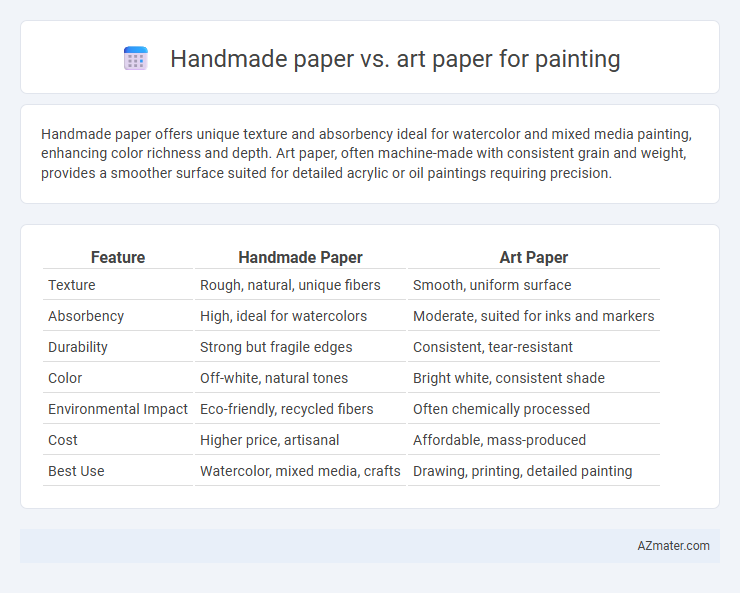Handmade paper offers unique texture and absorbency ideal for watercolor and mixed media painting, enhancing color richness and depth. Art paper, often machine-made with consistent grain and weight, provides a smoother surface suited for detailed acrylic or oil paintings requiring precision.
Table of Comparison
| Feature | Handmade Paper | Art Paper |
|---|---|---|
| Texture | Rough, natural, unique fibers | Smooth, uniform surface |
| Absorbency | High, ideal for watercolors | Moderate, suited for inks and markers |
| Durability | Strong but fragile edges | Consistent, tear-resistant |
| Color | Off-white, natural tones | Bright white, consistent shade |
| Environmental Impact | Eco-friendly, recycled fibers | Often chemically processed |
| Cost | Higher price, artisanal | Affordable, mass-produced |
| Best Use | Watercolor, mixed media, crafts | Drawing, printing, detailed painting |
Introduction to Handmade and Art Paper
Handmade paper is crafted using traditional methods involving natural fibers such as cotton or linen, offering a unique texture and increased absorbency ideal for watercolor and mixed media painting. Art paper, typically machine-produced, provides a smoother, more uniform surface designed for consistent application of acrylics, oils, and digital printing. Artists often choose handmade paper to emphasize texture and organic qualities, while art paper suits detailed and precise artwork requiring even pigment distribution.
Defining Handmade Paper
Handmade paper is crafted using traditional techniques involving natural fibers such as cotton, hemp, or mulberry, resulting in a textured, absorbent surface ideal for watercolor and mixed media paintings. Unlike art paper, which is machine-produced for uniformity and smoothness, handmade paper features unique irregularities and a robust composition that enhances pigment adhesion and longevity. Artists often prefer handmade paper for its archival quality and organic aesthetic that adds depth and character to their artwork.
Understanding Art Paper
Art paper offers a smooth, consistent surface tailored for various painting mediums, enhancing pigment adherence and detail clarity. Handmade paper features unique texture and absorbency, influencing paint interaction and creating distinct visual effects favored in traditional and contemporary artworks. Selecting between handmade and art paper depends on the desired aesthetic, medium compatibility, and the artist's technique requirements.
Texture Differences
Handmade paper features an uneven, fibrous texture with natural irregularities that enhance the tactile quality of paintings, offering unique depth and character ideal for watercolor and mixed media. Art paper, typically machine-made, possesses a smoother, more consistent surface that allows for precise detail and uniform paint application in styles requiring sharp lines, such as acrylics or inks. The choice between handmade and art paper significantly impacts the final artwork's texture, absorbency, and visual effect, making texture differences crucial for artists to consider based on their medium and desired finish.
Absorbency and Paint Compatibility
Handmade paper offers superior absorbency due to its natural fibers and uneven texture, allowing it to hold water-based paints like watercolor and gouache effectively without warping. Art paper, often coated and smoother, tends to resist ink and paint absorption, making it ideal for acrylics and oils that require less surface penetration. The choice between these papers depends on the paint medium, with handmade paper enhancing water-based media interaction and art paper supporting heavier, less absorbent paints.
Durability and Longevity
Handmade paper offers exceptional durability due to its dense fiber composition and traditional crafting process, which enhances its resistance to wear and environmental factors. Art paper, typically machine-made, varies in quality but often contains additives that can affect its longevity over time, making it less ideal for archival purposes. Artists seeking paintings with long-lasting vibrancy and structural integrity often prefer handmade paper for its superior aging characteristics.
Color Vibrancy and Finish
Handmade paper offers unique texture and absorbency that enhances color vibrancy by allowing pigments to settle deeply, creating rich and organic finishes ideal for watercolors and mixed media. Art paper, typically smooth and coated, provides a uniform surface that maintains brightness but can limit pigment absorption, resulting in sharper but less textured color presentation. Choosing handmade paper emphasizes depth and natural variation in color, while art paper focuses on precise, consistent finishes suitable for detailed and graphic work.
Environmental Impact and Sustainability
Handmade paper is crafted from natural fibers, often recycled or sustainably sourced, resulting in a biodegradable and eco-friendly option with minimal chemical use, reducing environmental pollution. Art paper, typically produced using industrial processes, consumes more energy and may involve synthetic additives, which can increase its ecological footprint despite offering a wide range of textures and finishes. Choosing handmade paper for painting supports sustainable practices by lowering carbon emissions and promoting resource conservation compared to conventional art paper production.
Cost Comparison
Handmade paper typically costs more than art paper due to its labor-intensive production process and unique texture, making it a premium choice for fine art painting. Art paper, often machine-made, offers a more affordable option with consistent quality and is widely available for various painting techniques. Cost differences can range from 20% to 50% depending on brand, paper size, and weight, impacting budget considerations for artists.
Choosing the Right Paper for Painting
Choosing the right paper for painting depends on the desired texture and absorbency, with handmade paper offering unique fibers and a rougher surface that enhances watercolor and mixed media effects. Art paper, typically machine-made, provides consistent weight and smooth finishes ideal for detailed work and ink-based techniques. Artists must consider factors like durability, surface texture, and paint type to select the most suitable option for their specific medium and style.

Infographic: Handmade paper vs Art paper for Painting
 azmater.com
azmater.com